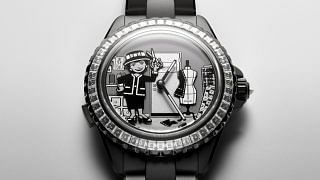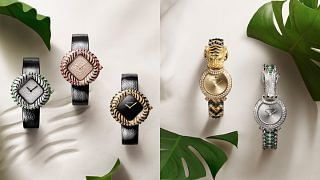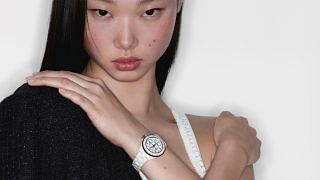Anyone who has followed British politics this week would know that a spider brooch broke the Internet. That jewellery belonged to Lady Brenda Hale, the United Kingdom’s Supreme Court president who delivered the stunning ruling that Boris Johnson’s prorogation of parliament was unlawful. But her whopper-sized arachnid brooch, pinned against an austere black dress, was a fashion salvo. It goes to show how jewellery has a strong unspoken power to make statements, both figuratively and sartorially. The interpretation is endless. She’s the stinger. She’s the spinner and weaver of destiny. Well, you get the idea.
Which brings us to fine jewellery designers Emily Tan (above left) and Anita Shewchuk (above right). For the record, the duo has nothing to do with Lady Hale. But the tale of the spider seems to resonate strongly with the kind of attention-grabbing jewellery and the subliminal message they create. Founded in 2018, their label Calla Lily can be said to be the well-guarded secret of local high-end jewellery seekers who head over to the classy mid-century style atelier in Eng Hoon Street for experimental and eclectic takes on nature-inspired designs or refreshingly architectural styles.

After a year of creating customised designs for their private clients, Tan and Schewchuk who cut their teeth at fashion labels like Marni and architecture firms like Takenouchi Webb respectively, are finally branching out to making ready-to-wear pieces. The debut collection called Bloom is a 30-piece outing that boasts the same kind of design M.O. the two are known for. Each piece features unexpected takes on gemstones that run the gamut from aquamarines, diamonds, emeralds, garnets, rubies, sapphires, spinels, and tourmalines.
Think pretty pink morganite ear studs in a cushion setting with removable diamond halo jackets. Or how about a playful take on a diamond band? Here, 12 perfectly-cut diamonds are set in an irregularly shaped band to create an organic-looking design. Like their customisable creations for private clients, the designs come with that playful factor too. Most of the designs comprise of modular parts which let one dismantle and combine different pieces of jewellery to create a unique look. After all, who says you can’t combine graphic paper plane-shaped earrings with flamboyant-looking mandarin garnets and diamond drops from a pair of chandelier earrings? At the end of the day, the message is clear: Don’t be too precious with your fine jewellery.
The Ready-To-Wear Debuts
How did your career in jewellery design begin?
Emily Tan: As a designer, I took my first steps into fashion in footwear. I joined Jimmy Choo Couture in London after I graduated from the London College of Fashion. Following a stint with Marni in Italy, I moved to Vietnam to work on costume jewellery. But my desire, really, was to create pieces that last. That’s why I moved back to Singapore and began designing fine bespoke jewellery and working with gems.
I went to the Gemological Institute of America (GIA) to study, test and identify gemstones, and was drawn to the beauty of gemstones. Coloured gems aren’t as easy to find in Singapore, and I liked their uniqueness – they don’t have the same uniformity you would find, say, in diamonds. I never looked back.
Anita Shewchuk: I discovered a natural flair for fine bespoke jewellery in 2016. I previously worked at architecture and design firms Ministry of Design and Takenouchi Webb. While on the lookout for new opportunities, I landed at a bespoke jewellery design house working under Emily who recognised my innate talent and unusual approach to shapes and lines. Last year, I joined Calla Lily.
How do your backgrounds in fashion and design come into play at Calla Lily?
ET: Coming from a fashion background, I’m always aware of how my jewellery designs would suit certain outfits and integrate into the lifestyle of the client. It also means I instinctively curate and combine coloured gemstones with different outfits. I’m a jewellery stylist as well as a designer. At Marni while working on footwear design, I learnt how to draw ideas from an eclectic mix of cultures. We created shoes with appliques ranging from Indian embroidery to South American handwoven pieces. From this experience, I realised there were no boundaries in design, between the ancient and modern, from East to West. That I could create freely, say, with a classical European inspired design, a gemstone from Brazil, sketching in my studio in Tiong Bahru.
During my time at Jimmy Choo couture, I worked with the renowned designer to create custom-made shoes for his clients. I saw how the bespoke service should be managed from beginning-to-end, with the necessary attention to detail. Jimmy Choo taught me how to create unique pieces while having a signature style and look. These are lessons I try to apply to Calla Lily.

There are a small number of young independent fine jewellery labels today who create stylish, modern and luxurious designs. Your label is one of them. But how do you differentiate yourself from others in this very niche market?
ET: I think we differentiate ourselves by having a fun and uninhibited take on luxury. We create statement pieces that can be worn every day, rather than only at cocktail parties. Our clients also value our ability to suggest designs like a jewellery stylist. We don’t focus on the sale, but on giving advice and educating, always co-creating with our clients.
With regards to our gems, we are unique in that we love to collect rare and unusual gemstones, such as a cat’s eye morganite which we recently made into a ring. Even though Morganites, in general, are considered readily available, a fine quality piece is rare. A cat’s eye gem of this calibre is something so special that most jewellers would have never seen it before.
AS: I feel that I differentiate myself by sticking to my interior design roots. I play with bold geometrical structures, such as the octagonal, square and compass rings. I also think that our dedication to listening to our clients, always sketching different options for them to choose from, and creating truly unique pieces makes us stand out.
Why did you decide to branch out into making ready-to-wear designs?
ET: We decided to launch a ready-to-wear collection to give clients the option of acquiring a piece they like right away, and to add modular pieces such as jackets, dangles and drops, to their jewellery they made with us previously. We love to create playful designs that can both stand on their own or be combined with other pieces to create new looks.

What are your favourite pieces from the collection?
ET: I love the Copacabana earrings as they symbolise ‘celebration’ in tune with our one-year anniversary. They are inspired by fireworks over a sunset sky, and are playful with drops that can be added for different degrees of dramatic detail. The piece includes Mandarin and Malaia garnets, yellow sapphires, and diamonds.
AS: I’m clearly biased because my favourites are the Octagon stack rings I designed. I love the bold angles and lines, which exude confident femininity. They are created to be layered and stacked, to play off the angular cuts and contrast with the delicate candy-like colours of the spinels, rubies, aquamarines, emeralds and diamonds.
How big is the portion of ready-to-wear designs in your business, compared to bespoke
pieces?
ET: Since we started Calla Lily, bespoke pieces have been our mainstay, representing over 90 per cent of our business, as most of our clients love to co-create with us. However, we do see our ready-to-wear sales growing steadily as more clients come in to buy gifts for loved ones, or bring their family and friends who are visiting Singapore for vacation; and purchasing jackets and dangles to complement existing pieces.

The notion of ready-to-wear brings to mind the idea of trendy desings. Would you say trends matter?
ET: We don’t really follow trends, as we like to be creative and do our own thing, but there are trends in coloured gemstones we’re seeing. Many are looking beyond the ‘Big Four’ – diamonds, emeralds, sapphires and rubies – and towards garnets, spinels and tourmalines in rare and unusual hues. What is especially popular right now are bi-coloured gemstones or stones that appear different under varying lighting and angles.
The Malaia garnet, for instance, shifts from peach to mauve, and the Burmese grey spinel can appear more grey or lavender depending on the lighting. These “interactive” experiences also extend to teal sapphires, which take on varying intensities of greenish-blue, and unheated Tanzanites, which can shift from greyish-to greenish-blue.
What is your approach to designing jewellery?
ET: We love to co-create. Clients tell us their stories, but also want the designer’s expert input in terms of style, setting and craft. We sometimes draw in more than one designer to introduce different possibilities. I have a keen eye for artisanal craftsmanship. My style is eclectic, and a lot of my designs are inspired by movement and nature, while Anita’s architecture background gives her a unique perspective on lines and shapes.
AS: Our process always starts with a conversation – a client shares their story, their likes and dislikes, and we create sketches until something takes shape. Sometimes the design is also inspired by the uniqueness of a chosen stone. The process is collaborative from start to end, and we don’t rush it. That is why it is hard to say exactly how long a piece takes – it can depend on the complexity. The process can take anywhere between two months and a year.
The name of your label Calla Lily calls to mind pretty feminine things. Is this an idea you encapsulate in your designs?
ET: My signature style is more classical and feminine, yet with a whimsical twist. We do want our pieces to be very pretty, but we don’t limit ourselves to that. We also make bespoke jewellery for men as well. For instance, a client had a wild-boar tooth handed down to him, and we created a very masculine looking pendant. My vision for Calla Lily is to be a place where eclectic design styles can take form. Hence, Anita’s style is very different from mine, with bold shapes and lines, and a post-modern feel. We hope in the future to work with more designers who have their own signature styles.

How important is it for your jewellery to be transformable?
ET: We think jewellery should be fun and playful, yet still sophisticated. So for us, creating modular and transformable pieces is an important criteria. We like pieces which can evolve and adapt, and sometimes we’re experimenting. We may create the earring studs first and then be inspired to design the dangles months later and be pleasantly surprised with the final result.
AS: Our clients love this too, as their jewellery never gets old. A piece from a year ago may be transformed by a new jacket, and it feels like a brand new look.
Where are your pieces made?
ET: We use master craftsmen in Singapore and Hong Kong. Depending on the type of design, we engage the craftsman who we think is most adept at creating that particular piece.
What are your influences as a jewellery designer and can you share how these translate into your work?
ET: The beauty of nature is my greatest inspiration and influence. Fractal geometry and the symmetry found throughout the natural world is something I love to emulate in my designs. From the way flowers and plants grow to the wings of a butterfly, I try to capture this beauty in jewellery. Hong Kong jewellery designer, Wallace Chan, has incredible work based on this theme, and he inspires me with the possibilities of design and craftsmanship.
AS: Working with Emily has been such an enriching experience for me. She encouraged me to pursue my own architectural style of jewellery, and not to conform to classical norms. I’m also influenced by our clients and their personal stories. For example, recently my client was captivated by the stars in the sky, and she wanted something a bit wild. So I sat with her and we sketched a fantastical constellation earring design, related to her star sign, Taurus.

One key issue that matters to young labels today is the sustainability and eco-consciousness of their production. How important is this for Calla Lily?
ET: We are nature lovers, and hence we feel it’s so important to preserve the beauty of this world. That’s one of the reasons why we think repurposing old jewellery, whether heirlooms or existing pieces is such a great idea. It’s a form of recycling and gives the jewellery new life. A gemstone set in a ring could become a pendant, earrings could be reset into rings, and a necklace could be recreated in a number of ways. Our client had a marquise diamond ring that she felt was too old fashioned. We restyled it into an armour ring that she now loves to wear.
AS: This is also why we believe in creating jewellery that is timeless and isn’t tied to trends. A bespoke piece is an expression of you that will last a lifetime. It reflects your own personal sentiments, so you won’t get tired of it.
ET: At our studio, we are also aware of the resources we consume on a daily basis and we do our part to conserve and recycle where we can. Even the smallest actions make a difference.













